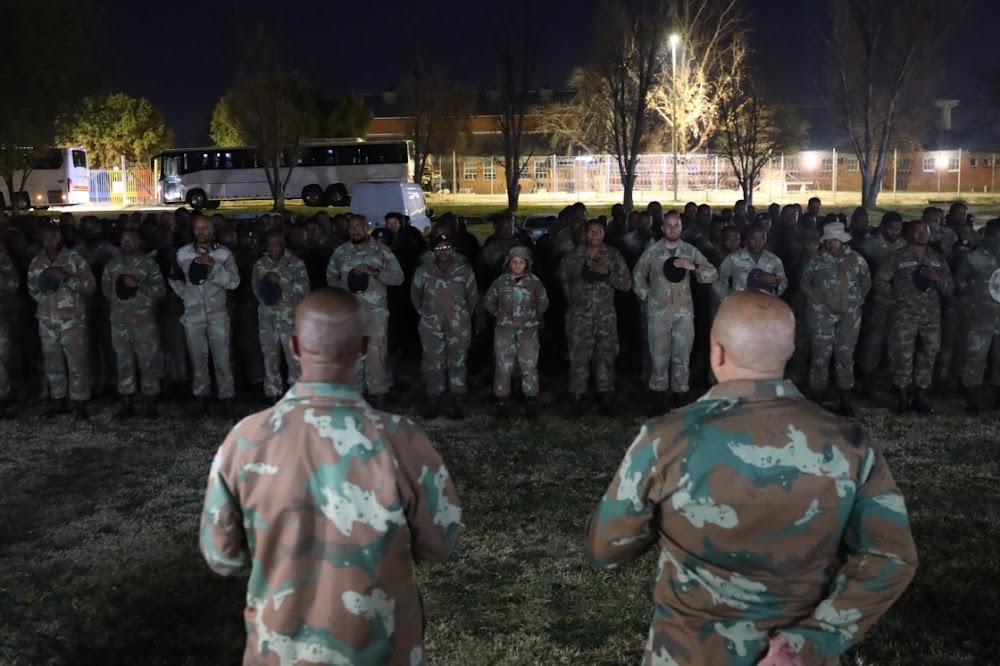Africa-Press – South-Africa. A second batch of 257 South African National Defence Force (SANDF) soldiers arrived at Air Force Base Waterkloof in Pretoria on Sunday after the termination of the Sadc Mission in the Democratic Republic of Congo (SAMIDRC). A third flight is expected on Monday.
A chartered Air Tanzania Boeing 787 landed in Pretoria late on Sunday afternoon after flying from the SAMIDRC staging ground in Tanzania. The troops on board were due to make their way to Bloemfontein for demobilisation, either by bus or on the SA Air Force’s single airworthy C-130 Hercules transport aircraft.
The SANDF in a statement said the phased return is part of the SANDF’s planned withdrawal from the mission area. “Upon their return, the troops will undergo the standard demobilisation programme, which includes health screenings, psychological support, and reunification services.”
The first 249 troops arrived on Friday evening. They were supposed to fly to Bloemfontein but as ground handling support was not in place, they were flown to Waterkloof and bussed overnight to Bloemfontein. The SANDF said it expected the return of remaining troops to be better co-ordinated.
Director of defence corporate communication Rear Adm (JG) Prince Tshabalala, acknowledged concerns over Friday’s delayed flight, saying its six-hour-plus delay was due to a last-minute aircraft change by Air Tanzania, which was beyond the control of the SANDF.
The airline “only notified the SANDF at a very late stage that they were experiencing challenges with passenger stairways, therefore opted to land in a bigger airport. To compound this, the SANDF was only informed shortly when the soldiers were en route about the aircraft that it could not land at Bram Fischer International Airport due to its size.”
The Sadc is organising logistics around the return of SAMIDRC troops, including those from the other two troop contributing countries (Malawi and Tanzania). “We remain committed to ensuring that all returning soldiers are welcomed home with dignity and that all future logistical arrangements are as seamless as possible,” Tshabalala said.
The repatriation process has generated criticism from many quarters. Chris Hattingh, DA defence and military veterans spokesperson, said the event in totality was another example of poor SANDF planning and “a national embarrassment”.
“The DA warned this event was more about spectacle than sincere recognition,” he said in a statement, adding, “those concerns were proven correct. The entire ceremony turned into a public embarrassment, with soldiers stranded and their supposed heroes’ welcome left in ruins”.
“This is not just a failed media stunt. It is a sign of deeper dysfunction within the department of defence (DoD). Repeated logistic failures, both abroad and at home, raise serious questions about leadership and competence at the highest levels.
“Our troops deserve more than press conferences and red carpets. They deserve clear planning, dignified treatment and respect. Not the humiliation of becoming pawns in a failed PR exercise,” according to Hattingh.
Tshabalala said it was “a bit unfair to suggest any operational shortcomings on the part of the SANDF when, in fact, we had no control over the logistical constraints presented by the service provider.”
The DA is calling for a full parliamentary report detailing the planning and procurement of repatriation logistics, the causes of delays in troop and equipment movement from Goma, DRC, the full cost of rerouting and VIP arrangements, the status and safety of remaining SANDF personnel and assets in the DRC, and what lessons, if any, have been learnt from this mission’s collapse.
“This farcical ‘homecoming’ is not merely a PR disaster. It reflects the SANDF’s growing inability to carry out even the most basic operations, troop movement, equipment return, or co-ordinated logistics, without confusion, delay, or last-minute crisis-driven haphazard improvisation. The minister’s own admission that ‘we would have just picked up our children and landed them at the airbase’ if the SANDF had working aircraft speaks volumes,” Hattingh said.
“No amount of spin can conceal the truth: SAMIDRC ended not in honour, but in disarray. If this is how South Africa withdraws from conflict, what confidence can we have in how it enters one?”
The remaining troops, said to number 2,000, serving with the now terminated SAMIDRC are due to return home by month-end. Equipment is being transported from Tanzania by sea and is expected to arrive later.
For More News And Analysis About South-Africa Follow Africa-Press






